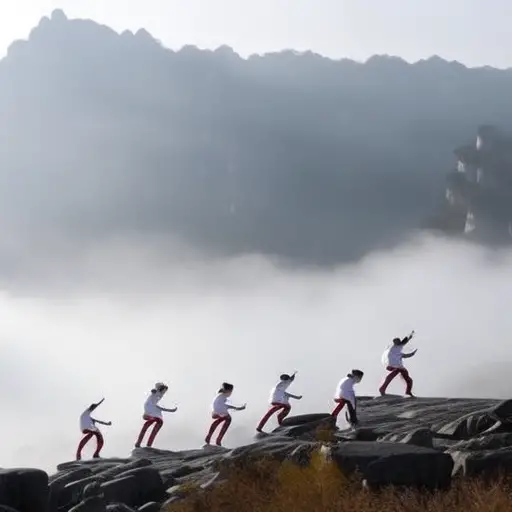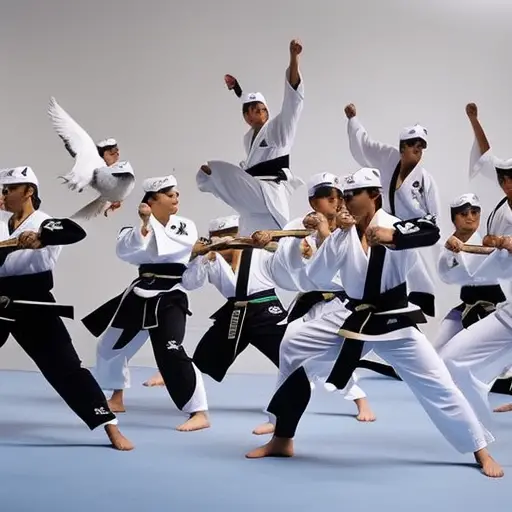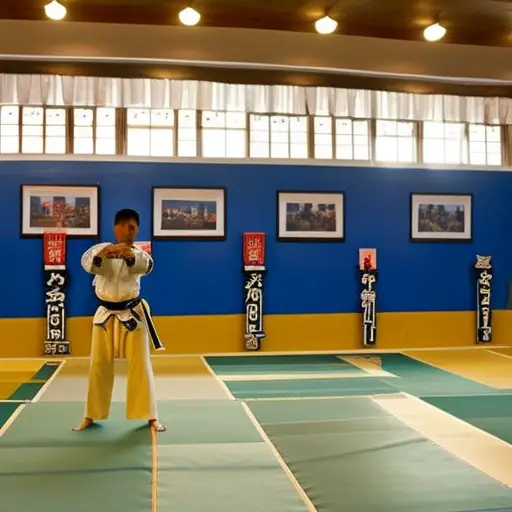The Experience of Training in Korea: The Birthplace of Taekwondo

Embark on a transformative journey as we delve into the intricate world of taekwondo training in its very birthplace, Korea.
Like a skilled artist wielding a brush, this article will paint a vivid picture of the immersive experience awaiting those who seek to master this ancient martial art.
From the rich history and traditional training techniques to the exhilarating sparring and competition, we will explore how training in Korea can shape personal growth and provide a deeper understanding of the martial arts heritage.
The History of Taekwondo in Korea
During the early 20th century, Taekwondo emerged in Korea as a result of the integration and evolution of various martial arts practices. The history of Taekwondo in Korea is deeply rooted in the country’s rich martial arts heritage. It draws influences from ancient Korean martial arts such as Taekkyeon and Subak, as well as from Japanese Karate, which was introduced during the Japanese occupation of Korea.
The evolution of Taekwondo can be traced back to the 1940s and 1950s when several Korean martial artists began to develop a unified system of martial arts that emphasized high kicks and fast strikes. This system was eventually named Taekwondo in 1955 by General Choi Hong Hi, who played a prominent role in its development and promotion.
Taekwondo gained international recognition and popularity after it was introduced as an official sport in the 1988 Seoul Olympics. Since then, it has become one of the most widely practiced martial arts in the world.
The history and evolution of Taekwondo in Korea laid the foundation for its growth and development. It has become an integral part of Korean culture and identity, with training centers and dojangs (training halls) spread across the country. These centers provide a space for practitioners to learn and hone their skills, contributing to the ongoing legacy of Taekwondo in Korea.
Training Centers and Dojangs in Korea
When it comes to training in Korea, the cultural impact cannot be ignored. The training centers and dojangs in Korea reflect the rich history and traditions of Taekwondo. These facilities are not just places to practice martial arts, but also serve as cultural hubs where students can immerse themselves in the authentic Korean experience of Taekwondo training.
Cultural Impact on Training
Regularly, training centers and dojangs in Korea play a significant role in shaping the cultural impact of Taekwondo. These institutions not only serve as places for physical training but also act as cultural hubs where practitioners can immerse themselves in the traditions and values associated with the martial art. One of the challenges faced by foreign practitioners is cultural adaptation, as they navigate through the unique customs and etiquette observed in Korean training centers and dojangs. Additionally, the language barrier can pose a hurdle, as most instructions and communication within these establishments are conducted in Korean. However, with the increasing popularity of Taekwondo worldwide, many training centers and dojangs in Korea have started to incorporate multilingual instructors and provide translations to accommodate international practitioners. This effort promotes inclusivity and allows for a more diverse and globalized approach to Taekwondo training.
| Challenges | Solutions | Benefits |
|---|---|---|
| Cultural adaptation | Incorporating multilingual instructors | Promotes inclusivity |
| Language barrier | Providing translations | Allows for globalized approach |
Authenticity of Training Facilities
The authenticity of training facilities, such as training centers and dojangs in Korea, is a crucial aspect that contributes to the overall experience of practicing Taekwondo in its birthplace.
These training facilities are designed to provide a conducive training environment that promotes the traditional values and principles of Taekwondo.
In Korea, training centers and dojangs are built with the aim of creating an authentic atmosphere that allows practitioners to fully immerse themselves in the art form.
From the architecture and design of the buildings to the equipment and training tools used, every aspect is carefully curated to reflect the rich history and cultural significance of Taekwondo.
The training environment in these facilities not only enhances the physical aspects of training but also fosters a sense of discipline, respect, and commitment among practitioners.
This authenticity in training facilities sets the stage for the subsequent section on traditional training techniques in Taekwondo.
Traditional Training Techniques in Taekwondo
Traditional training techniques in Taekwondo encompass a wide range of effective methods that have stood the test of time. These techniques not only focus on physical strength and skill development, but also hold cultural significance within the practice of Taekwondo.
Effective Training Methods
One of the most influential training methods in Taekwondo is the use of forms. Forms, also known as poomsae or patterns, are a series of predetermined movements that practitioners perform in a specific order. These forms are essential in developing a strong foundation in Taekwondo and improving various aspects of training.
Here are four reasons why forms are effective in Taekwondo training:
-
Training Intensity: Forms require practitioners to perform a sequence of movements with precision and power. This helps improve overall physical conditioning and strength.
-
Mental Discipline: Practicing forms requires focus, concentration, and discipline. It enhances mental fortitude and helps develop a strong mind-body connection.
-
Technique Development: Forms allow practitioners to practice and perfect various techniques, including kicks, strikes, and blocks. This improves technique execution and accuracy.
-
Muscle Memory: Repeatedly practicing forms helps develop muscle memory, allowing practitioners to perform techniques instinctively in real combat situations.
Cultural Significance of Techniques
While many of the techniques used in Taekwondo have practical applications in self-defense, they also hold deep cultural significance that reflects the history and values of Korea.
Taekwondo is deeply rooted in Korean culture, and its techniques have been influenced by various cultural influences over the years. The training philosophy in Taekwondo emphasizes discipline, respect, and self-control, all of which are key values in Korean society.
The techniques themselves embody these values through their precise and controlled movements, as well as their focus on mental and physical strength. The cultural significance of the techniques in Taekwondo goes beyond mere self-defense, as they serve as a way to connect practitioners with their Korean heritage and instill important cultural values.
Understanding and mastering the basic forms and techniques is essential in developing a strong foundation in Taekwondo and preparing for more advanced training.
Mastering the Basic Forms and Techniques
Practitioners of Taekwondo must diligently practice and refine their execution of the basic forms and techniques in order to achieve mastery in the martial art. This requires a deep understanding of timing and rhythm, as well as the ability to refine kicking techniques. Here are four key aspects that practitioners must focus on in their journey to mastering the basic forms and techniques:
-
Precision: In Taekwondo, every movement must be executed with precision. Practitioners must pay close attention to the details of their forms and techniques, ensuring that each movement is performed with accuracy and control.
-
Power: Taekwondo is known for its explosive and powerful kicks. Mastering the basic forms and techniques involves developing the strength and power needed to deliver impactful strikes. This requires consistent practice and conditioning to build muscular strength and improve kicking technique.
-
Speed: Speed is crucial in Taekwondo, as it allows practitioners to quickly execute their techniques and effectively counter their opponents. By mastering timing and rhythm, practitioners can enhance their speed and react swiftly to their opponent’s movements.
-
Fluidity: Fluidity refers to the seamless flow of movements in Taekwondo. Practitioners must strive to perform their forms and techniques with grace and fluidity, ensuring that each movement transitions smoothly into the next.
Sparring and Competition in Korea
Sparring and competition in Korea provide taekwondo practitioners with valuable opportunities to test their skills and showcase their abilities on a competitive stage. In Korea, sparring techniques are honed through rigorous training and a focus on precision and speed. The training intensity is high, with practitioners constantly pushing themselves to improve and excel in their techniques.
To understand the significance of sparring and competition in Korea, let’s take a look at the following table that highlights the key aspects of this practice:
| Aspect | Description |
|---|---|
| Training Techniques | Practitioners learn a variety of sparring techniques, including kicks, punches, and blocks. |
| Strategy | Training focuses on developing effective strategies to outsmart opponents and score points. |
| Protective Gear | Competitors wear protective gear such as helmets, chest protectors, and shin guards for safety. |
| Scoring System | Points are awarded based on the accuracy and power of strikes, with different values assigned. |
| Competition Levels | Competitors can participate in various levels of competition, from local tournaments to national events. |
Sparring and competition in Korea not only enhance the technical skills of taekwondo practitioners but also foster a sense of discipline, resilience, and sportsmanship. These experiences serve as a stepping stone for individuals who aspire to compete at higher levels and represent their country in international competitions.
Transitioning from the discussion of sparring and competition, the next section will delve into the immersion of taekwondo practitioners in Korean culture and customs.
Immersion in Korean Culture and Customs
Additionally, a significant number of taekwondo practitioners fully immerse themselves in Korean culture and customs during their training experience in Korea. This immersion allows them to not only improve their martial arts skills, but also gain a deeper understanding and appreciation of the rich heritage and traditions of the country.
Here are four aspects of Korean culture and customs that taekwondo practitioners often explore:
-
Korean Cuisine: Training in Korea provides an opportunity for practitioners to sample and savor the diverse flavors of Korean cuisine. From the famous and spicy kimchi to the mouthwatering bulgogi, they can indulge in a wide array of delicious dishes that are unique to Korea. Sharing meals with fellow practitioners also fosters camaraderie and strengthens bonds.
-
Traditional Attire: Taekwondo practitioners often have the chance to don traditional Korean clothing, such as the hanbok, during cultural activities or demonstrations. Wearing these traditional garments not only enhances the overall experience but also allows practitioners to connect with the historical roots of the art.
-
Cultural Events and Festivals: Immersion in Korean culture means participating in various cultural events and festivals. From traditional dance performances to music concerts, practitioners can witness and engage in the vibrant and colorful celebrations that showcase the country’s rich cultural heritage.
-
Language and Etiquette: Training in Korea also provides an opportunity to learn the Korean language and etiquette. Practitioners can pick up basic phrases and customs, allowing them to communicate better with locals and deepen their cultural understanding.
Exploring the Martial Arts Heritage in Seoul
Moreover, Seoul, the capital city of South Korea, offers a multitude of opportunities for individuals to delve into and appreciate the rich martial arts heritage of the country. From martial arts festivals to the presence of famous taekwondo masters, Seoul provides an immersive experience for those interested in martial arts.
One of the key events in Seoul’s martial arts calendar is the Seoul International Wushu Festival. This festival showcases various martial arts styles, including taekwondo, judo, and kendo, through performances and competitions. It attracts participants from all over the world and offers a platform for practitioners to demonstrate their skills.
Additionally, Seoul is home to renowned taekwondo masters who have made significant contributions to the development and promotion of this martial art. These masters, such as Grandmaster Choi Hong Hi and Grandmaster Kim Bok Man, have trained countless students and have left a lasting legacy in the world of taekwondo.
To provide a visual representation, the table below highlights some of the martial arts festivals and famous taekwondo masters in Seoul:
| Martial Arts Festivals | Famous Taekwondo Masters |
|---|---|
| Seoul International Wushu Festival | Grandmaster Choi Hong Hi |
| Grandmaster Kim Bok Man | |
Exploring the martial arts heritage in Seoul not only allows individuals to witness and learn from the best, but it also provides an opportunity for personal growth and development. By immersing oneself in the rich history and traditions of Korean martial arts, individuals can gain a deeper appreciation for the values of discipline, respect, and perseverance that are inherent in these practices.
The Impact of Training in Korea on Personal Growth
Training in Korea has a significant impact on personal growth, allowing individuals to develop not just their physical skills, but also their mental resilience and cultural understanding. The rigorous training regimen and the immersive cultural experience contribute to the holistic growth of individuals. Here are four ways in which training in Korea can have a profound impact on personal growth:
-
Improvement in Mental Health: The intense physical training in Taekwondo helps individuals release endorphins, which are known to enhance mood and reduce stress. Moreover, the discipline and focus required in training help individuals develop a sense of control over their thoughts and emotions, leading to improved mental well-being.
-
Building Discipline: Training in Korea emphasizes discipline, which plays a crucial role in personal growth. Through consistent practice and adherence to strict training routines, individuals learn to cultivate discipline not just in their martial arts practice but also in other aspects of their lives. This discipline can have a ripple effect, positively impacting their work ethic, time management, and overall self-discipline.
-
Enhancing Focus: Taekwondo training requires intense concentration and focus. Practitioners are trained to block out distractions and remain present in the moment. This focus extends beyond the training mat and can significantly improve an individual’s ability to concentrate on tasks, make informed decisions, and maintain mental clarity in various aspects of life.
-
Cultural Understanding: Training in Korea provides individuals with a unique opportunity to immerse themselves in the country’s rich cultural heritage. By learning about the history, traditions, and values associated with Taekwondo, individuals develop a deeper understanding and appreciation for Korean culture. This cultural understanding fosters open-mindedness, tolerance, and a broader perspective on the world.
Frequently Asked Questions
What Are the Different Belt Levels in Taekwondo and How Long Does It Take to Achieve Each Level?
There are several belt levels in taekwondo, each representing a different level of proficiency. The time it takes to achieve each level varies depending on the individual’s training duration, cultural practices, and training methods employed.
Are There Any Age Restrictions for Training in Taekwondo in Korea?
Age restrictions for training in Taekwondo in Korea vary depending on the specific school or organization. While many schools accept students as young as 3 or 4 years old, there is no upper age limit for training. Training requirements are typically based on the individual’s skill level and dedication to the practice.
Can Foreigners Participate in Taekwondo Competitions in Korea?
Foreigners are allowed to participate in Taekwondo competitions in Korea, providing opportunities for foreign Taekwondo practitioners to showcase their skills and compete at the birthplace of this martial art.
How Do the Training Methods in Korea Differ From Those in Other Countries?
Training methods in Korea differ from other countries through their emphasis on traditional techniques, discipline, and cultural immersion. Korean training techniques are known for their rigor, focus on form and precision, and the incorporation of ancient philosophies and values.
Are There Any Specific Cultural Practices or Customs That Students Need to Be Aware of When Training in Korea?
When training in Korea, it is important for students to be aware of cultural etiquette and language barriers. Understanding and respecting Korean customs and traditions will enhance the training experience and foster a deeper connection with the birthplace of Taekwondo.
Conclusion
In conclusion, training in Korea, the birthplace of Taekwondo, offers a unique and enriching experience. From learning about the history of Taekwondo to mastering its traditional techniques, students are immersed in a culture deeply rooted in martial arts.
The opportunity to spar and compete in Korea further enhances one’s skills and understanding of this discipline. Additionally, the exploration of Korean customs and the martial arts heritage in Seoul provide a holistic experience that fosters personal growth and development.
Training in Korea truly ignites a transformative journey in the world of Taekwondo.




